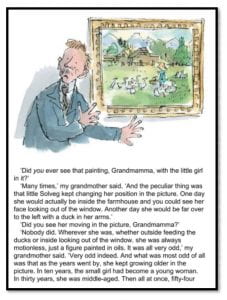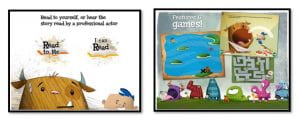eBook – The Witches
- Book Title – The Witches
- Target Age – 8-11 years
- Author – Roald Dahl
- Category – Non Fiction
- Language – English
- Platform – Kindle/eReader
- Cost – Colour Edition $14.99
The Witches, written for young adult readers by the popular children’s author Roald Dahl and illustrated by Quentin Blake is one of ‘phizzwhizzing’ and witchery. Cleverly written with a masterful command of made up adjectives, this story is about witches who live among us in our every day world. Centred around the Grand High Witch and her gang, Roald Dahl hooks his readers in with humour, shock and interesting storylines. ‘Dahl is a master of keeping-your-attention – not only within his stories but with regard to the flow of his prose – and lo, it is good.’ (French 2010) So well is it written, that this text has been reproduced in several formats such as audiobooks, eBooks and movie versions of the book with the first one released in 1990 starring Angelica Huston and a remake is planned for 2021 starring Anne Hathaway.
The colour eBook edition enhances the typical electronic reading experience by cleverly replicating the colour paper book version of the same story. Whilst you pay a little more for this version it is definitely worth the extra few dollars as Quentin Blake’s signature illustrations help to bring the wacky story to life. The eBook version is recommended due to its portability and cleverly designed features that almost replicates a physical book. Electronic books can do certain things that print books cannot, and therein lies their value. Enhanced electronic books are changing our definition and expectations of books. (Sadokierski 2013)

“Normal” eBooks are essentially digital versions of regular books that are usually read on devices like the Kindle, iPad and Nook. For most of their history, eBooks have been quite similar to their paper-based counterparts in terms of content. (Leelefever 2012) The benefits of an eBook is that it allows the user to carry several titles in one device and is simple to use with most eReaders navigable simply by pressing the screen to turn the page, it incorporates a library and home screen to select titles and has WIFI access to the store to easily purchase other eBook files as required.
With no significant differences to the paperback version of The Witches, one might wonder what the benefits are of purchasing an eBook. Whilst the immersive experience of this text is not in its digital features and rather in the masterful writing, it makes sense for young readers to transition to digital formats. This allows readers to continue to use 21st Century navigational skills of digital devices and one that many young readers will feel familiar with and even expect. Take for instance, the young child who couldn’t understand why her magazine page couldn’t be pinched or tapped for interactivity (UserExperiencesWorks, 2011). There is now an expectation from a young age that everything can be touched, swiped and zoomed.
Specifically using this text on an eReader will provide cost and storage space savings for schools. The question to ask for this particular book is what affordances the digital version offers that enhance and extend the print book (Yokota and Teale, 2014). Young adult readers will already have well developed skills to navigate the device required to access the eBook. Yokota and Teale discuss this and other questions around the use of apps in literacy education, and provide educators with some particularly insightful criteria to evaluate quality digital texts. It is therefore important for educators to select the mode in which texts are presented to learners and ensure that there are direct benefits to this mode of presentation whilst considering current and future trends in technological advancements.
In this instance, it is the text itself that can provide strong Victorian Curriculum links specifically in English and links to the other formats in which this text is presented can lend itself to reading and viewing and responding to texts. Some of these could include;
- Recognise and analyse the ways that characterisation, events and settings are combined in narratives, and discuss the purposes and appeal of different approaches (VCELT374)
- Synthesise information from multiple sources and use lateral thinking techniques to draw parallels between known and new solutions and ideas when creating original proposals and artefacts (VCCCTQ034)

Comparing and contrasting the text in a variety of formats can invoke critical thinking and encourage higher order questioning that a Middle Years student is required to demonstrate in order to meet curriculum learning outcomes. The Witches is an exemplary model of engaging literature suitable for such a learning purpose.
- Click to purchase the eBook The Witches
- Images retrieved from Amazon
References
Dahl, R. The Witches Retrieved from https://www.amazon.com.au/Witches-Roald-Dahl-ebook/dp/B002VISNLC
French, J (2010, Oct 30) Review: The Witches Retrieved from http://www.kids-bookreview.com/2010/10/review-witches.html
Leelefever (November 2012) What is an “Enhanced” eBook? Retrieved from https://www.commoncraft.com/what-enhanced-ebook
Victorian Curriculum Assessment and Authority (VCAA) Victorian Curriculum English: Year 5-9 Continuum, Critical and creative Thinking https://victoriancurriculum.vcaa.vic.edu.au/level7?layout=1&d=CCT&d=E
UserExperiencesWorks. (2011, Oct 6). A magazine is an iPad that does not work [Video file]. Retrieved from https://www.youtube.com/watch?v=aXV-yaFmQNk&feature=youtu.be
Yokota, J. & Teale, W. H. (2014). Picture books and the digital world: educators making informed choices. The Reading Teacher, 34(6). Retrieved from http://www.academia.edu/3886534/Picture_Books_and_the_Digital_World_Educators_ Making_Informed_Choices
Enhanced Book – Even Monsters Get Sick
- Book Title – Even Monsters Get Sick
- Target Age – 4+ years
- Author – Michael Bruza
- Category – Education/Fiction
- Language – English (available in other languages)
- Platform – iPad only
- Cost – $0.99 AUD
Even Monsters Get Sick is an interactive story for early years learners that was developed by Busy Bee Studios in 2012 and can be purchased via iTunes or the App store for 99 cents. Busy Bee studios is also responsible for the development and publishing of other educational children’s enhanced eBooks by a variety of authors.
Written and designed especially for preschool and early primary students, this digital story provides young digital natives with a well-illustrated and colourfully animated story that addresses some real life issues that they may encounter in a school setting.
Even Monsters Get Sick is a story about a boy named Harry who traded some items with a friend in the playground for her monster named Zub. The monster seems unhappy which is why she traded him, after visiting the doctor Harry discovers that Zub is unwell with a cold. Harry nurses Zub back to full health. When he is well again, Harry’s friend tries to trade back for Zub however Harry decides that caring for Zub in sickness has resulted in a close friendship with his monster.
Developing further from the basic ebook technology, a more curious breed are “enhanced eBooks”, which include audio-visual and interactive elements such as short videos and animations. (Sadokierski 2013) Even Monsters Get Sick, provides all of the necessary features to appeal to young audiences, whilst still maintaining the familiarity of a physical book, these include arrows to ‘turn the page’, text and images just like you would find in a regular printed children’s book. The enhanced eBook then moves away from a regular eBook with features such as an upbeat soundtrack, songs and sound effects targeted to keep readers engaged and interacting with the story. It includes animations and short clips where questions are posed to the reader for them to think of potential answers, readers can then respond through game scenarios and feel like they are part of the story for as stated by (Pappas 2019) Involving learners is key to engaging them and making sure that the information actually sticks.
This book has been well received by reviewers and educators with several awards and accolades, some of these for Bruza’s Even Monsters Get Sick include:
- Featured in USA Today
- Featured in the For Dummies book “iPad Apps for Kids: For Dummies”
- Parents’ Choice Gold Award winner
- Kirkus Reviews “Best of”
- Best Apps for Kids “Best of the Best”
- com “Top Apps For Kids”
The design of this interactive eBook lends itself well for use in education settings and can be used to compliment a variety of Victorian Curriculum learning outcomes developed by the Victorian Curriculum Assessment Authority (VCAA). When utilising eBooks in early years, priority should be given firstly to the content quality of the digital narrative, including the supportive features and literary merits (Dobler, 2013, p.20). This eBook provides features that young 21st Century learners will be familiar with such as touch, press, listen and swipe however, in this instance the storyline, accompanying animations and games are targeted towards specific learning outcomes. For example, Even Monsters Get Sick includes 6 different games embedded into the story line designed to encourage reader engagement with the characters and encourages problem solving skills. Some of these games include mazes, shape matching and a treasure hunt.
The VCAA Foundation to Year 2 continuum provides links that educators can draw upon in the areas of Personal Learning Capabilities, Digital Technologies, English, Mathematics and Thinking Capabilities. Simple navigation tools such as arrows, a home button and contents page can encourage little learners to navigate simple texts and their features meeting Digital Technologies Outcomes. The story line includes a message and teaching for students teaching concepts such as health considerations, friendships and caring for others. These topics can prompt Personal and Social Capabilities lessons. Read aloud or self-read options also account for different reading abilities and model pace and flow by a young child narrator. It provides further opportunities for the child to read the text on their own therefore complimenting English developmental outcomes.

Whilst interactive eBooks are bright and engaging, Dobler (2013, p.20) warns of the risk on interactive texts being more distracting than motivating, in particular, when using texts with multimedia elements, educators need to choose texts that deepen the reader’s understanding and appreciation of the story. Therefore, strategic use of such eBooks should be carefully considered by educators with a clear intent and success criteria in mind. Another drawback of this text is that it was made specifically for Apple touch screen devices in 2012 and with the competitive nature of available android devices now readily available on the market, this eliminates a large proportion of the potential market based on device choice. Never the less, Bruza’s Even Monsters Get Sick is highly recommended for those little readers learning in a digital age.
- Visit the App Store to purchase Even Monsters Get Sick
- Click for other similar interactive children’s books
- Images retrieved from App Sliced
References
Busy Bee Studios. Even Monsters Get Sick retrieved from App Store https://apps.apple.com/us/app/even-monsters-get-sick/id535303119
Dobler, E. (2013, April/May). Looking Beyong the Screen: Evaluating the quality of Digital Books. Reading Today, 30(5), p. 20. Retrieved from www.reading.org.
Dube, M. (January 2019) Interactive Ebooks: What Are They and How to Make Them publish drive retrieved from https://blog.publishdrive.com/5-things-everybody-gets-wrong-interactive-books/
Pappas, C (March 2019) eBook Release – Interactive Learning
Design: Using An Interactive Learning Software To Increase Engagement In eLearning Courses (Web Blog Post) Retrieved from https://elearningindustry.com/interactive-learning-design-software-increase-engagement-free-ebook
Sadokierski, Z. (2013, November 12). What is a book in the digital age? [Web log post]. Retrived from http://theconversation.com/what-is-a-book-in-the-digital-age-19071
Victorian Curriculum Assessment and Authority (VCAA) Victorian Curriculum English: A-D and Foundation-Year 2 Continuum https://victoriancurriculum.vcaa.vic.edu.au/foundationlevel?layout=1&d=E
Interactive Book – Virtual Histories Roma
- Book Title – Virtual Histories Roma
- Target Age – 14+ years
- Author – Arnoldo Mondadori Editore S.p.A.
- Category – Education/Non Fiction
- Language – English (available in multiple languages)
- Platform – iPad only
- Cost – $9.99 AUD
Virtual Histories Roma, produced by Mondadori, is an enhanced book where readers are transported back in time through a guided exploration of ancient Rome which was the capital of the largest empire in the ancient world. The app takes readers through a fully immersive virtual experience of reconstructed city streets, ancient buildings and even allows you to manipulate and explore models of the gladiators, war engines and legionaries. The interactivity and flexibility provides astonishing experiences that no print book could ever replicate (Sadokierski, 2013) and Virtual Histories Roma boasts 3D models of ancient Roman buildings such as the Colosseum and Hadrian’s Museum.
Whilst navigating your way through the app, the user feels like they have been transported to another time whilst learning the secrets and stories of this ancient civilisation. As stated by (Pappas 2019) Telling a story is one of the oldest and most traditional human skills around. People like stories because they evoke emotions. What is great about an engaging story is that it often includes a lesson which can be learned.
Designed for confident readers and digital users, who can confidently navigate menus, hyperlinks, clickable endnotes and accessing links outside resources which are basic features of every enhanced book (Dube 2019) Virtual Histories Roma allows them to not just read but to engage, interact and experience. The interactive element of the story appeals to the contestant or learner because of the acknowledgment of their presence. The work by itself is re-affirming and a positive association follows. (Pappas 2019). In an educational setting this is particularly important for young adult learners as they achieve immediate feedback from their interaction whilst still within the text.
Not all interactivity is initially made obvious to the reader. It can take some investigation around the screen to find out where all of the features and capabilities are hidden, interactive books such as Virtual Histories Roma do require the reader to understand how the interactive elements work with the story (Lamb, 2011, p.13) to be successful with reaching its full potential. The digital manipulability of texts is transformative for teaching, learning and assessment practices. Virtual Histories is considered among the first applications to use ‘bubble viewer’ technology, which was conceived in Italy and patented in the USA. The system uses sensors built into the moving books (accelerometer and compass) to create a new generation of illustrations in digital bubble form. (Educational App Store)
The educational opportunities for using this enhanced eBook aligns well with the Victorian Curriculum in several learning outcome areas, and in particular Ancient History and English. Some of these outcomes include:
- Explore the ways that ideas and viewpoints in literary texts drawn from different historical, social and cultural contexts may reflect or challenge the values of individuals and groups (VCELT403)
- Recognise and explain differing viewpoints about the world, cultures, individual people and concerns represented in texts (VCELT406)
- How physical features influenced the development of the civilisation (VCHHK109)
- Causes and effects of contacts and conflicts with other societies and/or peoples, resulting in developments such as expansion of trade, colonisation and war, and spread of beliefs (VCHHK112)
It is dependent on educators to strategically select how this text will be used and which curriculum areas to link. The use of the immersive 3D enhanced book allows students to utilise technology to enhance their learning as Robin (2009) suggests that teachers need to encourage the correct use of the technology, offering support throughout the reading experience in order to integrate the technology for instruction.
Developers have considered several safety aspects around exposure to young readers and have included privacy and security settings and blocked in app purchases. For such a multilayered and multi modal text, regular updates are required, and there have been several, to ensure the continued function of the enhanced eBook. Educators must account for this as these updates need to be managed within the class to ensure all students can access the working app. It is also important to consider the purchase cost of $9.99 per iPad as a factor for viability in a school setting, as the app is Apple specific and each device requires a different paid account. This can be expensive option for a school setting and one that needs to be taken into consideration if it was to be utilised as a tool for learning in schools.

The ability to participate in such an immersive experience is imperative for modern day students and as stated by Malita, Digital storytelling provides students with the development of skills necessary to be effective in the 21st Century (Malita 2010), therefore despite costs and other set up considerations, Virtual Histories Roma is highly recommended for an educational and realistic trip down the laneways of ancient Rome.
- Click to download Virtual Histories Roma
- Images retrieved from Educational App Store
References
Educational App Store. Virtual History – Roma retrieved from https://www.educationalappstore.com/app/virtual-history-roma
Lamb, A. (2011). Reading redefined for a transmedia universe. Learning and leading with technology, 39(3), 12-17. Retrieved from http://ezproxy.csu.edu.au/login?url=http://search.ebscohost.com/login.aspx?direct=true&db=ehh&AN=67371172&site=ehost-live
Malita, L., & Martin, C. (2010). Digital Storytelling as web passport to success in the 21st Century. Procedia-Social and Behavioral Sciences, 2(2), 3060-3064. http://www.sciencedirect.com/science/article/pii/S1877042810005057
Pappas, C (March 2019) eBook Release – Interactive Learning Design: Using An Interactive Learning Software To Increase Engagement In eLearning Courses (Web Blog Post) Retrieved from https://elearningindustry.com/interactive-learning-design-software-increase-engagement-free-ebook
Robin, B. R. (2009, October 14). Digital Storytelling: A Powerful Technology Tool for the 21st Century Classroom. Theory Into Practice, 47(3), 220-228.
Sadokierski, Z. (2013, November 12). What is a book in the digital age? [Web log post]. Retrieved from http://theconversation.com/what-is-a-book-in-the-digital-age-19071
Victorian Curriculum Assessment and Authority (VCAA) Victorian Curriculum: Year 7-10 Critical and Creative Thinking, History and Geography https://victoriancurriculum.vcaa.vic.edu.au/level8?layout=1&d=E&d=H

